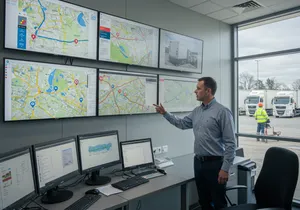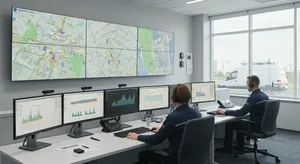Key System Components
- GPS tracking hardware units
- Mobile data transmission systems
- Central management software
- Reporting and analytics tools
- These system components work together to provide thorough fleet visibility
This page contains GPS tracking information. Use the table of contents to jump to specific sections. FAQ sections can be expanded using Enter or Space keys.
Commercial vehicle tracking systems transform fleet operations through data-driven insights and real-time monitoring. Fleet managers gain visibility into vehicle locations, driver behavior, and operational metrics that directly impact the bottom line.
Vehicle tracking systems serve as the backbone of modern fleet operations. These systems combine GPS technology, cellular communications, and data analytics to provide real-time insights into vehicle operations.

Commercial vehicle tracking systems provide comprehensive fleet management capabilities. Monitor vehicle locations, driver behavior, and operational efficiency with integrated GPS technology.

Commercial vehicle tracking systems include route optimization, predictive maintenance, and geofencing capabilities. These features reduce operational costs and improve efficiency.

Commercial vehicle tracking systems provide 24/7 fleet monitoring with instant alerts. Monitor vehicle locations, speeds, and operational status through integrated platforms.

Commercial vehicle tracking systems analyze operations to identify cost savings and efficiency improvements. Optimize routes, vehicle utilization, and driver performance.

A commercial vehicle tracking system is a comprehensive fleet management platform that combines GPS technology, cellular communications, and data analytics to provide real-time insights into vehicle operations and fleet performance.
Commercial vehicle tracking works by installing GPS tracking hardware units in vehicles that collect location data and transmit it through cellular networks to central management software for real-time monitoring and analysis.
The main components include GPS tracking hardware units, mobile data transmission systems, central management software, and reporting and analytics tools that work together to provide comprehensive fleet visibility.
Most commercial vehicle tracking systems update vehicle locations every 30 seconds during normal operation, providing near real-time visibility into fleet operations and vehicle status.
Core tracking features include real-time vehicle tracking, route history and analysis, driver behavior monitoring, GPS coordinate precision tracking, and integrated hardware and software platforms.
Route optimization analyzes traffic patterns, customer schedules, and vehicle capacity to create efficient routes, with systems typically reducing daily mileage by 21-35% while increasing service capacity.
Predictive maintenance alerts monitor vehicle diagnostics and predict maintenance needs before breakdowns occur, preventing emergency repairs that cost 65% more than scheduled maintenance.
Geofencing technology creates virtual boundaries around customer sites, service areas, or restricted zones, sending instant alerts when vehicles enter or exit designated areas for enhanced operational control.
Real-time monitoring features include live fleet dashboards with 30-second updates, alert systems for violations, emergency response features, and 24/7 operational status tracking.
The alert system provides instant notifications for speeding violations, unauthorized vehicle use, maintenance requirements, route deviations, and other operational events through multiple communication channels.
Emergency response features include panic buttons and emergency alerts that provide immediate assistance, automatically notifying authorities and providing exact GPS coordinates for rapid response.
Vehicle utilization analysis identifies underutilized vehicles and helps optimize fleet size by showing which vehicles are productive and which are redundant, enabling right-sizing based on actual usage data.
Driver performance optimization provides coaching opportunities to improve efficiency and safety, with performance metrics identifying training opportunities and rewarding top performers for better driving habits.
Route planning and optimization can save significant fuel costs, with one courier service saving $29,000 annually through efficient route creation that considers traffic, customer time windows, and vehicle capacity.
Compliance features include DOT compliance tracking, hours of service monitoring, safety behavior monitoring, and maintenance compliance tracking to help maintain regulatory requirements and avoid violations.
Safety monitoring tracks speeding, harsh braking, and reckless driving behaviors in real-time, helping coach safer driving habits with most companies seeing accident rates drop 36-46% within the first year.
Reporting capabilities include business reports with visual trends, cost analysis by vehicle or driver, performance benchmarking across the fleet, and comprehensive analytics for better decision-making.
Software integration connects with most dispatch software, accounting systems, and customer management tools, allowing tracking data to flow automatically into existing programs without double data entry.
Mobile applications provide the same functionality as desktop platforms, allowing fleet managers to monitor operations from anywhere while drivers can update job status and communicate without phone calls.
Implementation is rapid with installation taking 15-25 minutes per vehicle while vehicles are parked, resulting in zero downtime, and most fleets becoming operational within a week of signing.
Most companies see the system pay for itself within 3-6 months through fuel savings, reduced insurance premiums, improved productivity, and prevented theft, with typical 11-vehicle fleets saving $16,000-$31,000 annually.